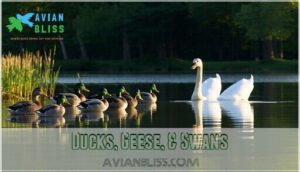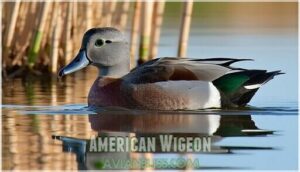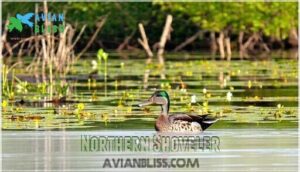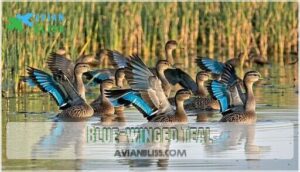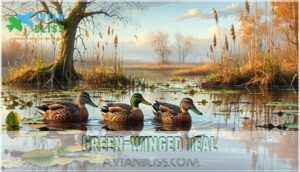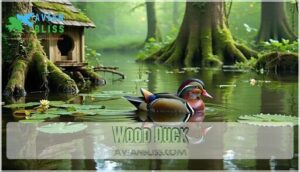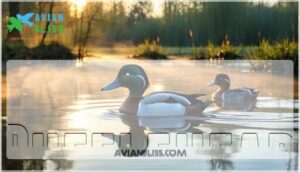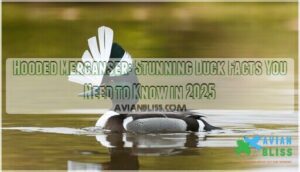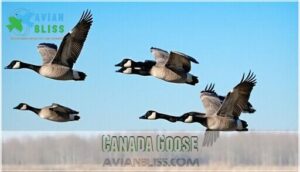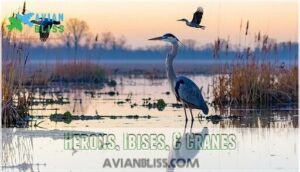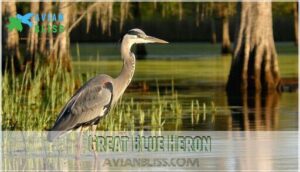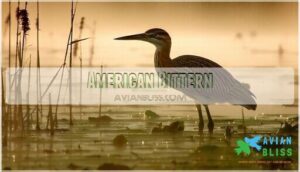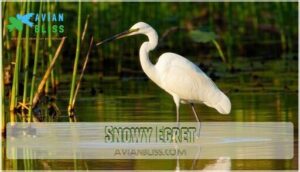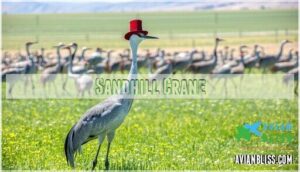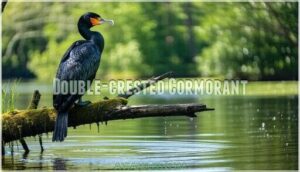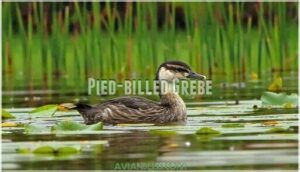This site is supported by our readers. We may earn a commission, at no cost to you, if you purchase through links.

The state’s 15,000 lakes and countless wetlands host 23 amazing water bird species, from the haunting Common Loon to massive American White Pelicans.
Whether you’re a weekend warrior with binoculars or just curious about those feathered friends at your local pond, water birds in Wisconsin offer something special.
You’ll spot colorful Wood Ducks hiding in marsh grasses, majestic Great Blue Herons standing like statues, and Canada Geese honking overhead.
Each species has adapted perfectly to Wisconsin’s unique aquatic habitats, and the secret to finding them lies in knowing exactly where and when to look, which can lead to incredible bird life and spotting massive American White Pelicans.
Table Of Contents
- Key Takeaways
- Ducks, Geese, & Swans
- Mallard
- American Wigeon
- Northern Pintail
- Northern Shoveler
- Blue-winged Teal
- Green-winged Teal
- Wood Duck
- Bufflehead
- Hooded Merganser
- Common Merganser
- Canada Goose
- Herons, Ibises, & Cranes
- Great Blue Heron
- American Bittern
- Snowy Egret
- Sandhill Crane
- Loons, Grebes, & Others
- Common Loon
- American Coot
- Double-crested Cormorant
- Pied-billed Grebe
- American White Pelican
- Frequently Asked Questions (FAQs)
- What are the wading birds in Wisconsin?
- What birds dive underwater in Wisconsin?
- What is the common water bird called?
- Which birds stay around water?
- When is the best time to spot water birds?
- What equipment do I need for birdwatching?
- How do I distinguish male from female ducks?
- Where are the top water bird locations in Wisconsin?
- What do water birds eat in different seasons?
- Conclusion
Key Takeaways
- You’ll find 23 amazing water bird species in Wisconsin’s 15,000 lakes and wetlands, from colorful Wood Ducks to massive American White Pelicans with nine-foot wingspans.
- You can easily identify different waterfowl by learning the key differences between dabbling ducks (like Mallards) and diving species (like Buffleheads and mergansers) based on their feeding behaviors.
- You’ll have the best success spotting water birds during early morning and late afternoon hours when they’re most active, especially at prime locations like Horicon Marsh and the Lower Wisconsin River.
- You’ll hear Wisconsin’s water birds before you see them – from the haunting wail of Common Loons echoing across misty lakes to the distinctive honking calls of Canada Geese in V-formations overhead.
Ducks, Geese, & Swans
Wisconsin’s water-world showcases an impressive collection of waterfowl that’ll make any bird enthusiast’s heart skip a beat.
You’ll discover three main groups of these aquatic athletes: ducks, geese, and swans.
Duck identification becomes easier once you understand the difference between dabbling ducks (like mallards) and diving species.
Wisconsin waterfowl includes over a dozen duck species Wisconsin birders can spot year-round, plus several goose species Wisconsin residents know well.
Waterfowl migration brings seasonal visitors, while some hardy species stick around all winter.
You’ll notice interesting nesting habits among different species – some prefer ground nests, others choose tree cavities.
Conservation efforts have helped populations recover from past declines.
Keep an eye out for hybrid waterfowl, which occasionally appear when different species interbreed.
These remarkable birds adapt to everything from urban ponds to remote wilderness lakes.
Mallard
You’ll easily spot male mallards by their glossy green heads and bright white collars – they’re like nature’s gentlemen in tuxedos. These iconic Wisconsin waterfowl are the duck equivalent of your friendly neighbor who adapts to any situation.
Wisconsin’s waters showcase feathered performers that’ll make your binoculars fog up with excitement.
Mallard Identification becomes simple once you know the basics. Males flash those stunning purple-blue wing patches during flight, while females sport mottled brown feathers that provide perfect camouflage. Both sexes share that distinctive curved black tail and orange-yellow legs.
Mallard Habitat spans from city park ponds to remote marshes across Wisconsin. They’re not picky – if there’s water, they’ll call it home. Mallard Diet includes everything from aquatic plants to insects and small fish, making them nature’s cleanup crew.
Mallard Behavior peaks during spring courtship when males bob their heads and whistle soft calls. Thanks to Mallard Conservation efforts, these resilient ducks remain Wisconsin’s most common water bird species year-round.
- Males develop breeding plumage in late fall
- Females can lay up to 13 eggs per clutch
- They’re excellent parents, leading ducklings to water within hours
- Urban mallards often lose their fear of humans completely
American Wigeon
You’ll love spotting American Wigeons with their compact bodies and distinctive round heads.
These charming ducks sport blue-gray bills tipped in black, making wigeon identification straightforward. Males flash green bands behind their eyes and white crowns, while females show brownish bodies with grayer heads.
Their wigeon habitat includes quiet lakes and marshes where they avoid crowds. Unlike other ducks, wigeon diet consists heavily of plant matter—they’ll even venture into farm fields like geese.
Listen for the male’s three-part whistle that sounds like a kazoo. These Wisconsin birds prefer staying away from people, making wigeon behavior somewhat secretive but rewarding to observe.
They’re easily recognized as one of the Wisconsin water birds, known for their distinctive round heads and blue-gray bills, and can be found in areas with quiet lakes and marshes, exhibiting unique wigeon behavior.
Northern Pintail
These elegant ducks stand out like dancers in the wetland ballet, with males sporting distinctive elongated tail feathers that earned them their name. Northern Pintail identification becomes easy once you spot the male’s chocolate-brown head, white breast stripe, and that signature pointed tail.
Females wear mottled brown camouflage perfect for nesting duties. Pintail migration brings these Wisconsin birds through our state during spring and fall, often stopping at Horicon Marsh and other shallow wetlands.
You’ll find them practicing their pintail habitat preferences – dabbling in marshes, flooded fields, and agricultural areas where they can tip forward to feed. Their pintail diet includes aquatic plants, seeds, and small invertebrates.
While still common, pintail conservation efforts focus on protecting prairie wetlands essential for breeding. These graceful water bird identification champions showcase Wisconsin wildlife at its finest. They’re considered to be surface feeding ducks.
Northern Shoveler
The Northern Shoveler’s spoon-shaped bill makes this duck impossible to miss among Wisconsin’s water birds.
You’ll spot this medium-sized dabbling duck filtering water through its oversized bill, searching for tiny crustaceans and seeds in shallow wetlands.
Males show off striking plumage variations during breeding season—glossy green heads, white chests, and rusty-brown sides that’ll catch your eye from across the pond.
Females sport mottled brown feathers with that same distinctive orange bill.
Their feeding behavior looks almost comical as they sweep their bills side-to-side like tiny shovels.
While their conservation status remains stable, protecting wetland habitat helps guarantee these quirky ducks continue gracing Wisconsin’s marshes and ponds each spring.
Blue-winged Teal
Blue-winged Teal are Wisconsin’s second-smallest dabbling ducks, measuring just 14-16 inches long.
These charming water birds sport distinctive sky-blue wing patches that flash brilliantly during flight.
Males showcase dark blue-gray heads with striking white crescents near their bills, while females display warm brown plumage with subtle facial markings.
Teal Identification and Behavior:
- Wetland Habitat: Prefer shallow marshes, flooded fields, and mudflats for feeding
- Migration Patterns: Long-distance travelers wintering in Caribbean and South America
- Breeding Habits: Nest in Prairie Pothole Region, responding to wetland conditions
- Conservation Status: Populations fluctuate based on breeding habitat availability
Watch for Bluewinged Teal in Wisconsin’s wetlands during fall migration, where these surface-feeding ducks gather in impressive flocks before their remarkable journey south.
Green-winged Teal
You’ll spot America’s smallest dabbling ducks gliding across Wisconsin’s shallow wetlands during spring and fall migration.
Green-winged Teal identification becomes easy once you notice the males’ cinnamon heads with that brilliant green stripe—like nature’s racing stripes.
These compact waterfowl prefer teal habitat in flooded fields and puddles, where their teal diet consists of seeds and aquatic plants.
Watch for their distinctive green wing patches flashing during takeoff. Teal conservation efforts protect the wetlands these charming ducks need for their incredible cross-continental journeys.
Wood Duck
Wisconsin water birds include many stunning species, but the Wood Duck stands out as the state’s most beautiful duck.
You’ll spot males with their iridescent chestnut and green plumage, while females display elegant grey heads with distinctive white eye patches.
These wetland birds prefer wooded swamps and streams over large open water.
Wood Duck nesting habits make them unique among ducks – they’re one of few species with strong claws for gripping bark and perching in trees.
Conservation efforts have boosted their population through nest box programs, helping combat habitat loss.
Their seasonal migration patterns are influenced by weather.
Their diet preferences include:
- Seeds and acorns from nearby trees
- Aquatic insects and invertebrates
- Small fish and plant matter
These common water birds produce distinctive hoots and squeals during courtship season.
Bufflehead
America’s smallest diving duck packs a punch with its oversized personality.
You’ll recognize the male Bufflehead’s striking black-and-white plumage with gorgeous purple-green plumage iridescence on his puffy head.
Females sport subtle gray-brown feathers with distinctive white cheek patches.
These wetland birds excel at diving behavior, plunging up to 30 feet deep for aquatic insects and crustaceans.
Their unique nesting habits involve old woodpecker holes, limiting their breeding range.
During Wisconsin’s spring and fall migrations, these diving ducks grace our marshes and lakes.
Their conservation status remains stable, making them reliable stars among Wisconsin water birds for dedicated birdwatchers seeking memorable foraging ecology observations.
Hooded Merganser
While buffleheads charm with their compact size, Hooded Mergansers captivate through their dramatic crest morphology and specialized hunting skills. These striking diving ducks showcase nature’s engineering prowess with their serrated bills designed for gripping slippery prey.
You’ll recognize males by their spectacular black-and-white crests that fan out like elaborate headdresses during courtship displays. Females sport more modest rusty-brown crests but share the same hunting expertise. Their fish diet requires constant diving in Wisconsin’s lakes and rivers, making them fascinating to watch.
Cavity nesting behavior sets these waterfowl apart from ground-nesting ducks. They’ll use old woodpecker holes or nest boxes you might spot near water. Here’s what makes Hooded Merganser watching rewarding:
- Dawn patrol – They’re most active in early morning hours
- Woodland edges – Look where forests meet water
- Diving displays – Watch their underwater fishing techniques
Their conservation status has improved dramatically thanks to habitat protection efforts across Wisconsin. These remarkable water birds prove that dedicated conservation works.
Common Merganser
Among Wisconsin’s diving ducks, the Common Merganser stands out as one of North America’s largest water birds.
You’ll recognize males by their iridescent dark green heads and striking scarlet-orange bills, while females sport rusty brown heads with the same vibrant bill coloring.
Their Merganser Diet consists primarily of fish, which they catch by diving beneath the surface.
Watch for their sleek bodies cutting through the water as they hunt.
Breeding Habits include nesting in tree cavities, particularly basswood trees in northern Wisconsin.
Their Physical Traits make them expert fishers, with serrated bills perfect for gripping slippery prey.
Habitat Preferences lean toward clear, fish-rich waters where they can showcase their remarkable diving abilities.
These impressive ducks prefer freshwater lakes and rivers throughout the state.
Canada Goose
You’ll spot Canada Geese almost everywhere in Wisconsin, from city parks to rural wetlands, thanks to their distinctive long black necks and bright white cheek patches that make them easy to identify.
These large, honking birds have become so common that you’ll likely hear their loud calls overhead before you even see their V-shaped flight formations crossing the sky, with their distinctive honking sounds being a key identifier, particularly the loud calls.
Common in Wisconsin
You’ll spot Canada geese practically everywhere in Wisconsin—they’re among the state’s most common water birds. These adaptable geese thrive in diverse habitats thanks to abundance factors like plentiful food sources and minimal predation.
Their population trends show remarkable success across the state.
- Honking flocks circling over shopping center parking lots
- Families grazing on manicured golf course fairways
- V-formations crossing sunset skies during seasonal changes
- Goslings paddling behind parents in suburban retention ponds
- Large groups resting on sandy lakeshores
Conservation efforts focus on managing their remarkable abundance rather than protection.
Heard in Wisconsin
Honking calls echo across Wisconsin’s skies as Canada geese announce their presence. You’ll recognize these distinctive Wisconsin sounds long before spotting the birds themselves. Their vocalizations serve as nature’s GPS system, keeping flocks connected during migration.
- Listen for loud honking calls that carry over long distances
- Watch for V-shaped formations flying overhead during fall migration
- Notice how their bird vocalizations increase near wetlands and lakes
- Hear seasonal calls intensifying during morning and evening hours
- Identify these common water birds by their unmistakable audible identification signature
These wetland noises symbolize changing seasons, making waterfowl watching memorable through sound alone. The presence of Canada geese is often marked by their distinctive vocalizations, which can be heard from a distance, and their V-shaped formations are a common sight during migration. The combination of these elements creates a unique experience, allowing observers to connect with wildlife through sound and sight.
Herons, Ibises, & Cranes
Elegance defines this remarkable family of wading birds Wisconsin. You’ll find herons, ibises, and cranes gracing wetlands with their statuesque presence and deliberate movements. These long-legged specialists have mastered the art of patience, standing motionless for minutes before striking with lightning speed.
| Species | Heron Identification | Conservation Status |
|---|---|---|
| Great Blue Heron | Gray-blue plumage, S-shaped neck | Stable |
| American Bittern | Streaked brown, secretive | Declining |
| Snowy Egret | Pure white, black bill | Recovering |
Crane Migration brings thousands through Wisconsin during spring and fall. Their trumpeting calls echo across marshes as they follow ancient flyways. Ibis Habitat remains limited here, with occasional vagrant sightings near southern wetlands.
These wading birds Wisconsin showcase incredible Nesting Habits, from platform nests in trees to ground-level rookeries. Common water birds like herons adapt well, while specialized species face habitat challenges.
Great Blue Heron
You’ll spot Great Blue Herons standing perfectly still along Wisconsin’s lakes and rivers, looking like they’re practicing yoga while waiting for fish to swim by.
These impressive birds fold their long necks into an "s" shape during flight and can be found throughout the state, making them one of Wisconsin’s most reliable water bird sightings.
Habitat in Wisconsin
Wisconsin’s extensive wetland habitats make perfect homes for Great Blue Herons year-round.
You’ll find these majestic water birds Wisconsin residents love along our lakes, rivers, and marsh habitats from spring through fall.
They prefer shallow waters with plenty of fish, frogs, and small mammals to hunt. Lake habitats like those near Madison and river habitats along the Wisconsin River provide ideal nesting sites.
Their migratory patterns bring them back each spring to establish territories in cattail-dense marshes throughout the state.
Many seek to improve Wisconsin heron habitats with various products.
YouTube Channel
Want to capture stunning footage of great blue herons? Check out BirdWatchingWisconsin’s YouTube channel for expert filming techniques and editing software tips.
You’ll discover monetization strategies while learning audience engagement tricks for your own water birds content.
Their tutorials cover everything from spotting ducks and geese to growing your channel through compelling Wisconsin bird watching videos, including tips on editing software and how to create content that showcases water birds.
American Bittern
Moving from the statuesque Great Blue Heron, you’ll find the American Bittern takes camouflage behavior to another level.
This medium-sized wading bird practically vanishes in Wisconsin’s marsh habitat, earning its reputation for secretive nature. When threatened, it points its bill skyward and freezes, blending perfectly with cattails.
You’ll hear its distinctive "oong-KA-chunk" call echoing across wetland habitats before spotting one. Listed as Special Concern, this water bird’s conservation status reflects declining populations.
Its identifying features include streaked brown plumage and a thick, compact body—making bird identification challenging but rewarding. Some hunters utilize an American Bittern decoy to attract these elusive birds.
- Master of disguise: Freezes with bill pointed up, mimicking marsh vegetation perfectly
- Vocal powerhouse: Produces haunting booming calls that carry across entire wetlands
- Stealth hunter: Stalks prey slowly through shallow water, striking with lightning speed
Snowy Egret
Despite being more common in southern regions, the Snowy Egret makes rare sightings in Wisconsin wetlands each year.
These elegant wading birds Wisconsin birders prize for their striking plumage details – pure white feathers contrasting with black bills and bright yellow feet that seem to glow underwater.
| Physical Feature | Description |
|---|---|
| Bill Color | Jet black, slender |
| Foot Color | Bright golden yellow |
| Size | Smaller than Great Egret |
You’ll spot their unique feeding habits in shallow marshes, where they actively dart and dance through water, using those yellow feet to stir up prey.
Their conservation status remains stable, though habitat preferences center on protected wetlands.
Water birds like egrets depend on clean, undisturbed marsh environments to thrive in Wisconsin’s challenging northern climate.
Sandhill Crane
You’ll spot these magnificent Sandhill Cranes during crane migration through Wisconsin’s birding hotspots Wisconsin. These towering gray water birds Wisconsin stand four feet tall, sporting crimson crowns and trumpeting crane calls that echo across wetlands.
Their elaborate mating rituals include graceful dancing displays that’ll leave you mesmerized. Simulating their presence can be aided with a realistic crane figure.
- Habitat requirements: Prefer shallow marshes and grasslands near wading birds Wisconsin
- Conservation efforts: Once endangered, now recovering through Wisconsin bird conservation programs
- Migration patterns: Travel thousands of miles between breeding and wintering grounds
- Social behavior: Form lifelong partnerships despite ongoing habitat loss challenges
Loons, Grebes, & Others
When you think of Wisconsin’s most mysterious water birds, loons and grebes top the list.
These fascinating waterfowl showcase incredible diving behavior that’ll leave you mesmerized.
Unlike typical ducks, they’re built for underwater hunting with legs positioned far back on their bodies.
You’ll find regional variations across Wisconsin’s lakes, from the northern wilderness to southern reservoirs.
Their conservation status varies by species, but habitat protection remains essential.
Listen for their haunting vocalizations echoing across quiet lakes at dawn and dusk.
Their unique nesting habits involve floating platforms anchored to emergent vegetation.
Grebes are particularly entertaining – they literally disappear underwater when threatened, earning the nickname "hell-divers."
These specialized water birds represent some of Wisconsin’s most elusive residents, requiring patience and persistence to observe properly.
Common Loon
On Wisconsin’s pristine lakes, you’ll hear the Common Loon’s haunting wail echoing across misty waters—nature’s most spine-tingling sound.
These remarkable aquatic birds dive up to 200 feet deep, their solid bones and rear-positioned webbed feet making them underwater torpedoes.
During breeding season, loons choose secluded rocky islands for nesting sites, building simple scrapes near water’s edge.
Their distinctive black-and-white checkered backs and dagger-like bills make identification easy.
Conservation efforts focus on protecting nesting habitat and reducing lead tackle poisoning.
Come fall, these magnificent water birds migrate south individually, their loon calls marking Wisconsin’s changing seasons perfectly.
American Coot
You’ll easily recognize the American Coot by its coal-black feathers and bright white, chicken-like bill.
These quirky water birds paddle around Wisconsin’s marshes and ponds, pumping their heads like tiny locomotives. Coot identification becomes simple once you spot their lobed toes—not webbed like ducks.
Their coot behavior includes aggressive territorial displays and comical running-on-water takeoffs. Coots prefer shallow wetlands rich in aquatic plants for their coot habitat, diving to grab vegetation and small fish for their varied coot diet.
Coot conservation depends on protecting Wisconsin’s precious wetlands for these entertaining waterfowl survivors.
Double-crested Cormorant
Unlike coots that paddle along the surface, expert divers like double-crested cormorants plunge deep for their fish diet. You’ll spot these dark water birds swimming low with just their necks above water. After fishing, they’ll perch with wings spread wide for wing drying – their feathers aren’t fully waterproof like ducks.
In Wisconsin, these skilled hunters differ from loons through their loon comparison reveals cormorants’ hooked bills and longer necks. Goose contrast shows cormorants’ sleeker build and diving behavior. Bird watching Wisconsin enthusiasts use this bird identification guide tip: look for the distinctive wing drying pose.
- Dive up to 25 feet deep for fish
- Spread wings to dry waterlogged feathers
- Swim with body submerged, neck exposed
- Form large nesting colonies on islands
- Distinguished by hooked bill and long neck
Pied-billed Grebe
You’ll spot this chunky little diver bobbing like a cork across Wisconsin’s wetlands.
The Pied-billed Grebe earns its name from that distinctive thick, chicken-like bill that turns white with a black band during breeding season.
These water birds are swimming machines, spending their entire lives paddling around marshes and ponds.
| Grebe Identification | Key Features |
|---|---|
| Size | Robin-sized, stocky build |
| Bill | Thick, blunt, whitish with black band |
| Behavior | Sinks like a submarine when alarmed |
| Habitat | Shallow marshes, ponds, slow rivers |
Their Grebe Diet includes small fish, aquatic insects, and crustaceans.
Watch their fascinating Grebe Behavior—they’ll disappear underwater instantly when threatened, popping up yards away.
These masters of Grebe Habitat conservation need healthy wetlands to thrive throughout Wisconsin.
American White Pelican
Among Wisconsin’s most spectacular waterfowl, you’ll spot American White Pelicans during their migration through the state’s waterways.
These massive aquatic birds aren’t year-round residents, but their Wisconsin sightings create unforgettable moments for bird enthusiasts.
Here’s what makes pelican migration and behavior so fascinating:
- Nine-foot wingspan – They soar effortlessly on thermal currents
- Cooperative feeding – Groups work together to corral fish into shallow water
- Massive bills – Can hold up to three gallons of water and fish
- Silent flight – Despite their size, they’re surprisingly quiet overhead
- Summer visitors – Best spotted from April through September
Their conservation status has improved dramatically since DDT bans.
Their identification tips help: look for pure white plumage, black wingtips, and distinctive orange bills during breeding season.
Frequently Asked Questions (FAQs)
What are the wading birds in Wisconsin?
You’ll find Great Blue Herons, Great Egrets, Green Herons, Black-crowned Night Herons, and American Bitterns wading through Wisconsin’s wetlands.
These long-legged birds hunt fish, frogs, and small creatures in shallow waters statewide, which makes them a fascinating sight in Wisconsin’s wetlands.
What birds dive underwater in Wisconsin?
Red-breasted Mergansers dive 250 times daily to catch fish! You’ll spot diving ducks like Canvasbacks, Buffleheads, and Common Goldeneyes plunging underwater for food in Wisconsin’s lakes and rivers year-round.
What is the common water bird called?
You’ll encounter the mallard most often – it’s Wisconsin’s most common water bird.
These adaptable ducks thrive everywhere from city ponds to wild wetlands, with males sporting those distinctive bright green heads.
Which birds stay around water?
You’ll spot ducks, geese, herons, and loons hanging around Wisconsin’s lakes and rivers. These water birds stick close to their liquid homes for food, shelter, and nesting spots year-round.
When is the best time to spot water birds?
Early morning and late afternoon offer your best chances for water bird watching.
They’re most active during these cooler hours, feeding and moving between roosting spots before settling in for midday rest.
What equipment do I need for birdwatching?
Like a detective gathering clues, you’ll need binoculars (8×42 works great), a field guide, notebook, and comfortable shoes. Don’t forget a camera, snacks, and patience—birds won’t pose on command!
How do I distinguish male from female ducks?
Male ducks typically show brighter, more colorful plumage with iridescent greens, blues, and bold patterns.
Females wear mottled brown feathers for camouflage while nesting.
Look for size differences—males are often larger.
Where are the top water bird locations in Wisconsin?
Wisconsin’s absolutely phenomenal birding hotspots include Horicon Marsh for herons and egrets, the Lower Wisconsin River for pelicans, and the Great Lakes shoreline for cormorants.
You’ll find incredible diversity at these prime wetland destinations, which are perfect for spotting cormorants.
What do water birds eat in different seasons?
You’ll find water birds switching their diets seasonally – they munch on aquatic insects, small fish, and plants during summer.
Then they shift to seeds, berries, and stored energy sources when winter arrives.
Conclusion
Amazing sights await you on Wisconsin’s waterways!
These water birds in wisconsin transform ordinary lake visits into extraordinary adventures.
You’ve discovered 23 incredible species, from the haunting loon’s call to pelicans soaring overhead.
Each outing brings new surprises—maybe a secretive bittern or colorful wood duck family.
Pack your binoculars, grab a field guide, and head to your nearest wetland.
Wisconsin’s feathered residents are waiting to share their aquatic world with curious observers like you.

